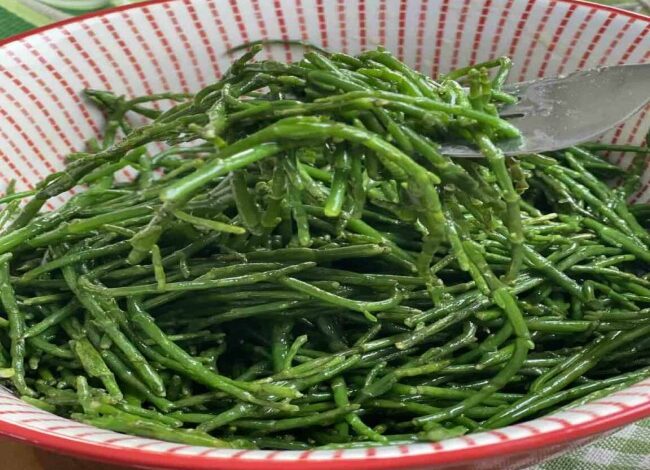How to Cook Samphire: A Complete Guide to Perfectly Preparing and Cooking Samphire

Samphire, a coastal plant growing along shorelines, is a delightful dish addition. Known for its salty, crisp flavor, samphire is highly valued in culinary circles for pairing well with seafood and salads and as a unique side dish. This guide will take you through everything you need to know about cooking samphire, including preparation, cooking methods like blanching, steaming, and frying, and timing tips to ensure a perfect result every time.
What is Samphire?
Samphire is a type of succulent plant that thrives in coastal regions. Its naturally salty taste and crisp texture make it an exciting addition to many dishes. You may find two types in markets: marsh samphire and rock samphire. Marsh samphire has a more delicate texture and salty taste, while rock samphire is often bolder and slightly bitter. Regardless of the type, both are easy to prepare and cook, making them accessible even for beginner chefs.
How to Prepare Samphire
Before cooking, preparing samphire properly is essential to ensure a clean, vibrant flavor in your dish.
- Cleaning: Rinse the samphire thoroughly under cold running water to remove any sand or grit. This is especially important as samphire grows in sandy coastal areas.
- Trimming: Remove any tough or woody stems. Fresh samphire should be vibrant green with tender stems, but the lower parts can be chewy. Trim these off if necessary.
- Blanching (Optional): Blanching is a quick way to soften samphire and lock in its color. Using it in salads or as a side dish without heavy cooking is beneficial.
How to Cook Samphire
There are multiple methods for cooking samphire, each bringing out different flavors and textures in the plant. Let’s explore each in detail:
Blanching Samphire
Blanching samphire is one of the simplest methods and a great way to enhance its flavor without overpowering it.
- Boil Water: Bring a pot of unsalted water to a rolling boil. Avoid adding salt, as samphire is naturally salty.
- Blanch: Add the cleaned samphire to the boiling water and cook for 2–3 minutes until it becomes tender but retains its crunch.
- Cool Down: Drain immediately and, if desired, plunge into ice water. This will stop the cooking process and help retain the vibrant green color.
- Serve: Drizzle with olive oil or add a knob of butter before serving. Blanched samphire is perfect as a side dish or in a cold salad.
Steaming Samphire
Steaming is another gentle cooking method that allows samphire to maintain its nutrients and crispness.
- Prepare Steamer: Place the samphire in a steamer basket over boiling water.
- Steam: Cover and steam for 3–5 minutes until the samphire is tender. Check the texture after a few minutes to avoid overcooking.
- Season: Serve with a sprinkle of black pepper. Steamed samphire pairs well with seafood, offering a mild, salty complement to grilled fish or shellfish dishes.
How to Cook Samphire Fry
Frying samphire brings out its natural saltiness and adds a rich depth of flavor. This quick method adds a bit of crunch, making it a fantastic option to elevate simple dishes.
- Heat Oil or Butter: Heat a tablespoon of olive oil or butter over medium heat in a frying pan.
- Add Aromatics: Add minced garlic to the pan and sauté for about a minute until it’s fragrant. Garlic adds a lovely base flavor that complements samphire well.
- Cook the Samphire: Add the samphire and sauté for 2–3 minutes, stirring frequently. Be careful not to overcook it, as you want the samphire to retain a slight crunch.
- Finish with Lemon: A squeeze of fresh lemon juice just before serving enhances the flavor and adds a touch of acidity that balances the saltiness.
Samphire Cooking Tips and Common Questions
Samphire: How to Cook and Serve
When cooking samphire, it’s essential to remember that less is often more. Because of its natural saltiness, samphire doesn’t need additional salt in most recipes. Use it to elevate simple dishes, particularly seafood, or add it to salads for an interesting texture contrast.
How Long to Cook Samphire?
The cooking time for samphire is short, typically just 2–5 minutes, depending on the method used. Overcooking can result in a mushy texture, so be sure to watch the time closely:
- Blanching: 2–3 minutes
- Steaming: 3–5 minutes
- Frying: 2–3 minutes
Keeping the cooking time short helps preserve the vibrant color and crisp texture that makes samphire unique.
Serving Suggestions for Samphire
Samphire’s briny flavor is ideal for pairing with a range of dishes. Here are a few serving ideas:
- Seafood Dishes: Samphire is a natural companion to seafood. Serve it alongside grilled fish, prawns, or scallops to complement the flavors.
- In Salads: Add blanched samphire to salads for a salty crunch. Its texture and color add visual and culinary interest to any mixed salad.
- With Lamb or Beef: Surprisingly, samphire pairs well with lamb and beef dishes, offering a salty bite that enhances the meat’s richness.
- In Pasta or Risotto: Stir in blanched or sautéed samphire to pasta dishes or risottos for an added layer of flavor and texture.
Storing Samphire
For best results, store fresh samphire in the refrigerator. Wrap it in a damp cloth or paper towel and place it in a plastic bag to retain moisture. Aim to use it within two to three days, as fresh samphire is best.
Final Thoughts on Cooking Samphire
Learning to cook samphire can transform your meals with a touch of seaside flavor. Whether you’re using it as a simple side dish, a crunchy salad addition, or a flavorful accent to seafood, this unique plant offers a delightful taste of the coast. Remember to keep cooking times short and avoid additional salt, as samphire’s natural saltiness is already quite pronounced.
You can enjoy samphire in various ways by mastering these simple cooking techniques, adding a new and exciting ingredient to your culinary repertoire.



